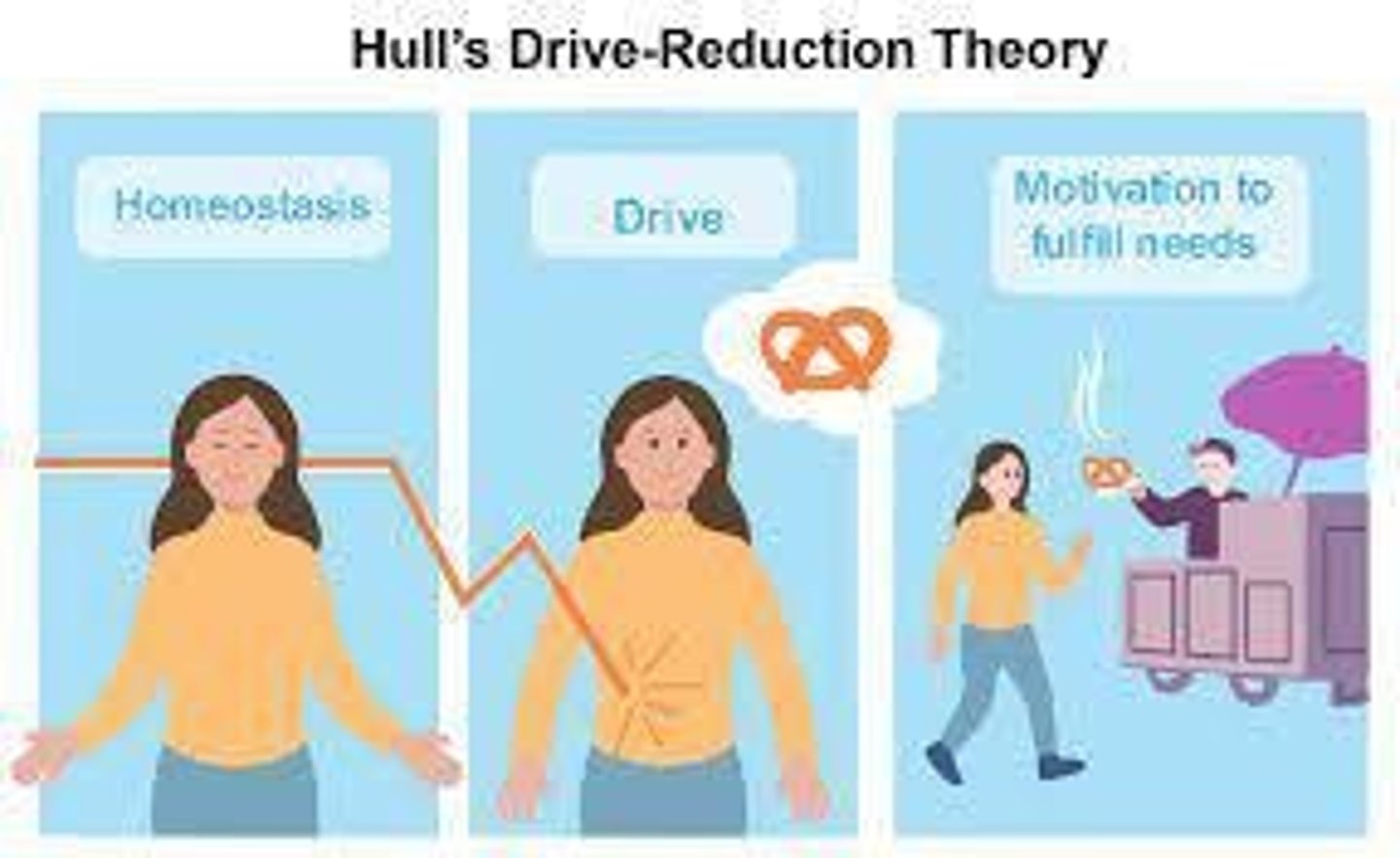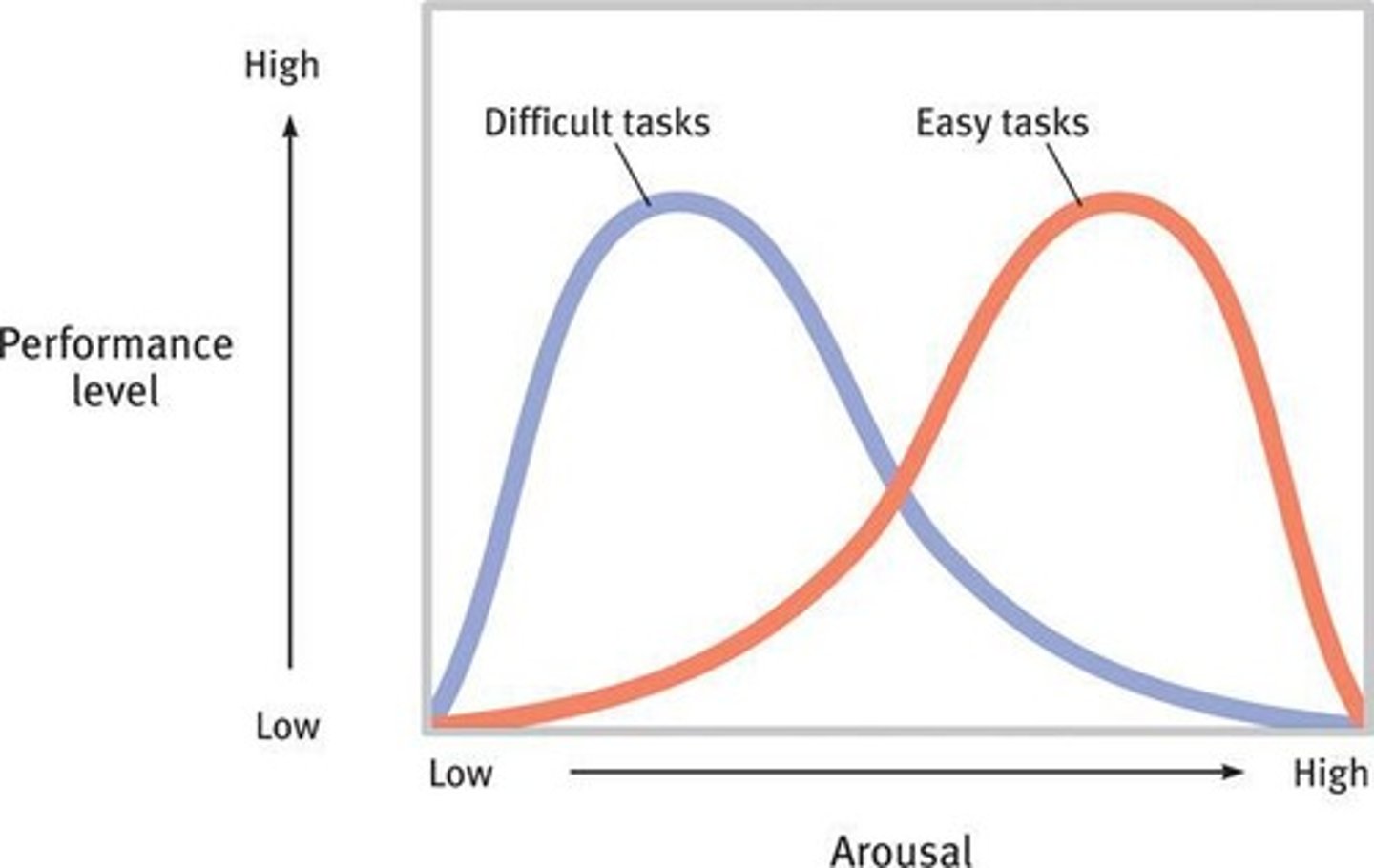4.6 AP PSYCH Theories of Motivation and Their Impact on Behavior
1/68
There's no tags or description
Looks like no tags are added yet.
Name | Mastery | Learn | Test | Matching | Spaced |
|---|
No study sessions yet.
69 Terms
Drive-reduction theory
Physiological needs create aroused states of tension (drives) that direct us to satisfy these needs.

Lewin's motivational conflicts theory
A theory that describes the conflicts that arise when making decisions between different motivations.
Homeostasis
Maintaining a steady internal state.
Approach-approach conflicts
Conflicts that occur when choosing between two desirable options.
Arousal theory
The theory that individuals are motivated to maintain an optimal level of arousal.
Approach-avoidance conflicts
Conflicts that arise when a single goal has both positive and negative aspects.
Optimal level of arousal
The ideal level of arousal for peak performance, which varies by individual.
Avoidance-avoidance conflicts
Conflicts that occur when choosing between two undesirable options.
Yerkes-Dodson Law
A principle that suggests there is an optimal level of arousal for performance, which varies with the difficulty of the task.

Sensation-seeking theory
The theory that individuals are motivated to seek out novel and intense experiences.
Self-determination theory
A theory that emphasizes the role of intrinsic motivation in driving behavior.
Experience Seeking
A component of self-determination theory that involves seeking out new experiences.
Intrinsic motivation
Motivation driven by internal rewards and personal satisfaction.
Thrill or Adventure seeking
A form of sensation-seeking characterized by the pursuit of risky or exciting experiences.
Extrinsic motivation
Motivation driven by external rewards or consequences.
Disinhibition
The reduction of restraint or inhibition, often leading to increased risk-taking behavior.
Incentive theory
The theory that behavior is motivated by a desire for external rewards.
Boredom susceptibility
A tendency to become bored easily, which can drive individuals to seek new experiences.
Instincts
Complex, unlearned behaviors/responses to stimuli that are rigidly patterned throughout a species.
Ghrelin
A hormone that stimulates appetite and plays a role in hunger regulation.
Leptin
A hormone that helps to regulate energy balance by inhibiting hunger.
Hypothalamus
A brain region that plays a crucial role in regulating hunger and thirst.
Pituitary gland
A gland that regulates various hormonal functions, including those related to growth and metabolism.
Motivation
A need/desire that energizes and directs behavior.
Cognitive
Mental conditions like consistency, balance, harmony between one's thinking/actions.
Drive-Reduction Theory
Activities that reduce tension caused by drive reduction are more temporarily pleasurable than long-term enjoyable.
Mihaly Csikszentmihalyi
Proposed that satisfying hunger/thirst feels good, but doesn't produce long-term feelings of well-being/happiness.
Enjoyable activities
Activities like altruism and participating in challenging, fulfilling activities produce good feelings that usually endure beyond the experience itself.
Criticisms of drive-reduction theory
Secondary reinforcers often reduce drives.
Pursuit of money
A powerful reinforcement/incentive, even though money (by itself) does nothing to reduce drives.
Hunger
Motivational factor that corresponds to stomach's contractions but can exist without stomach pangs.
Neural areas within hypothalamus
Monitor blood chemistry (including glucose level) and incoming information about the body's state.
Glucose
Form of sugar that circulates in blood, providing a major source of energy for body tissues.
Hunger signaling
When glucose levels drop, stomach/intestines/liver signal brain to motivate eating; brain then triggers feelings of hunger.
Hypothalamus
Contains the arcuate nucleus, responsible for secreting appetite-stimulating/suppressing hormones.
Lateral hypothalamus
Appetite-stimulating area; if electrically stimulated, even well-fed rats begin to eat.
Ventromedial hypothalamus
Appetite-suppressing area; if destroyed, rats show no interest in food.
Ghrelin
Secreted by empty stomach; sends 'I'm hungry' signal to brain.
Gastric bypass surgery
Seals off part of the stomach, so less ghrelin is produced/transmitted.
Leptin
Secreted by fat cells; brain increases metabolism/decreases hunger.
Environmental factors of hunger
Situations that can determine what you eat and how much, including time of day, taste preferences, culture, arousal, presence of others, and serving size & selection.
Optimal Arousal Theory
Some behaviors are prompted by a search for an optimum level of arousal rather than reducing physiological needs.
Moderate arousal
Can be motivating, leading to higher levels of achievement.
Too much stimulation
Motivates us to decrease arousal.
Optimal Arousal Theory
Suggests that too much stimulation can be stressful and produce anxiety.
Yerkes-Dodson law
Performance on a task increases with arousal up to a point; beyond that, performance decreases.
Adrenaline junkies
Individuals who enjoy high arousal and are likelier to seek out new music, foods, and engage in risky behaviors.
Exploration behavior in well-fed animals
Well-fed animals leave safety of shelter to explore and gain information in absence of any observable need-based drive.
Lack of stimulation
Often leads people to look for ways to increase arousal.
Yerkes-Dodson Law
Moderate arousal leads to optimal performance on most tasks.
Optimal level of arousal
Depends on task difficulty; more difficult tasks require lower arousal, while less difficult tasks are better with higher arousal.
Sensation-Seeking Theory
People are motivated by a need for varied or novel experiences that produce complex/intense sensations.
Experience seeking
Desire for new/novel/unique sensory or mental experiences.
Thrill/adventure seeking
Involves danger; individuals disregard risks, often referred to as 'adrenaline junkies.'
Disinhibition
Lack of self-control/restraint.
Boredom susceptibility
Aversion to routine/everyday life experiences; inability to tolerate monotony or repetition.
Self-Determination Theory
Humans have three basic needs that motivate them: autonomy, competence, and relatedness.
Autonomy
Feeling like they have agency/choice; not compelled to do things.
Competence
Mastering skills/material; being effective at things.
Relatedness
The need to feel connected/belong with others.
Intrinsic motivation
Desire to perform a behavior well for its own sake; enhances feelings of competence, autonomy, and relatedness.
Extrinsic motivation
Desire to perform a behavior to receive promised rewards or avoid punishment.
Overjustification
The overuse of bribes/rewards in motivation, leading to seeing actions as externally controlled.
Drive-reduction theory
Motivation by internal factors.
Incentive theory
Motivation by the acquisition of external rewards.
Approach-approach conflict
Must choose between two desirable outcomes.
Avoidance-avoidance conflict
Must choose between two unattractive outcomes.
Approach-avoidance conflict
Exists when one event/goal has both attractive and unattractive features.
Multiple approach-avoidance conflicts
Must choose between two or more things, each with both desirable and undesirable features.